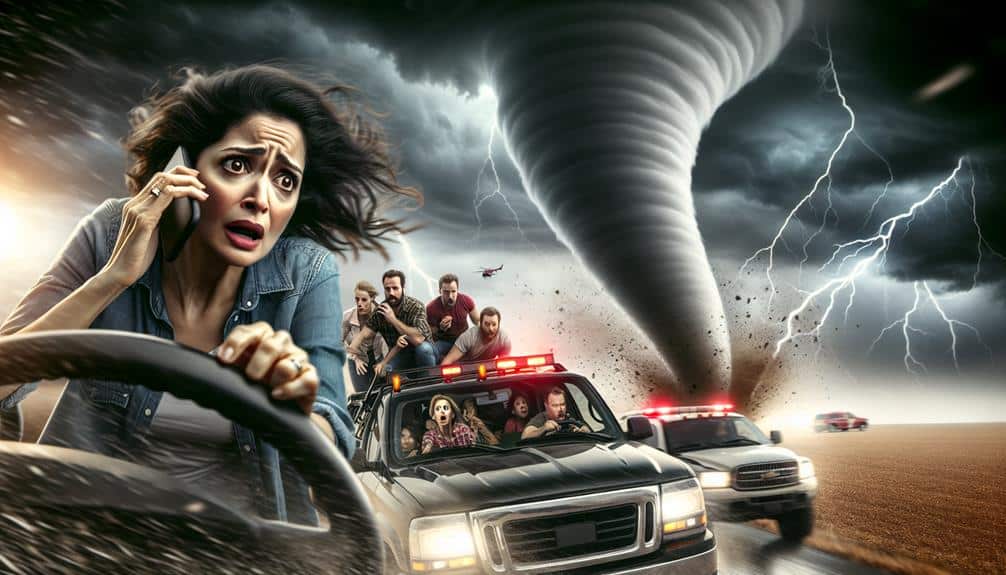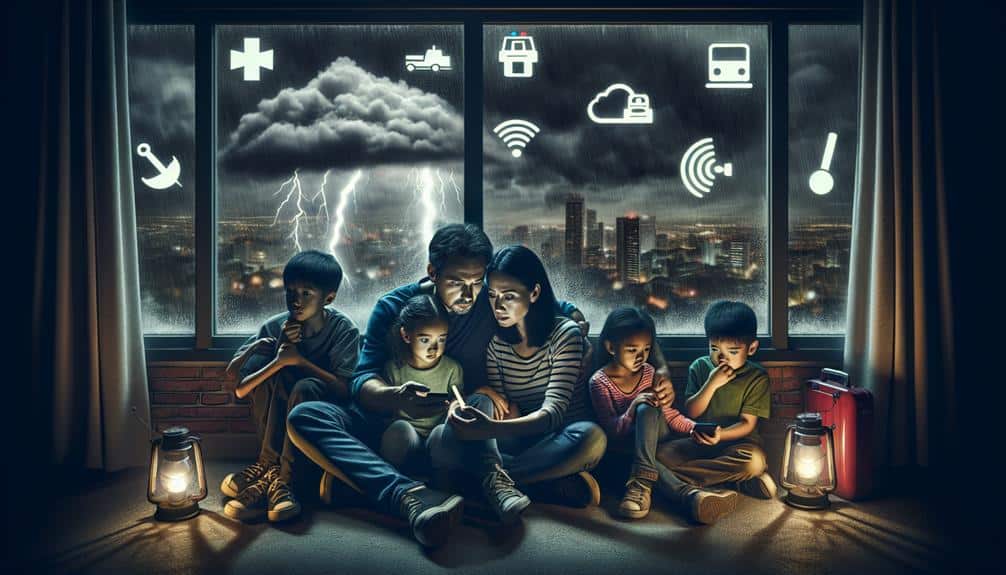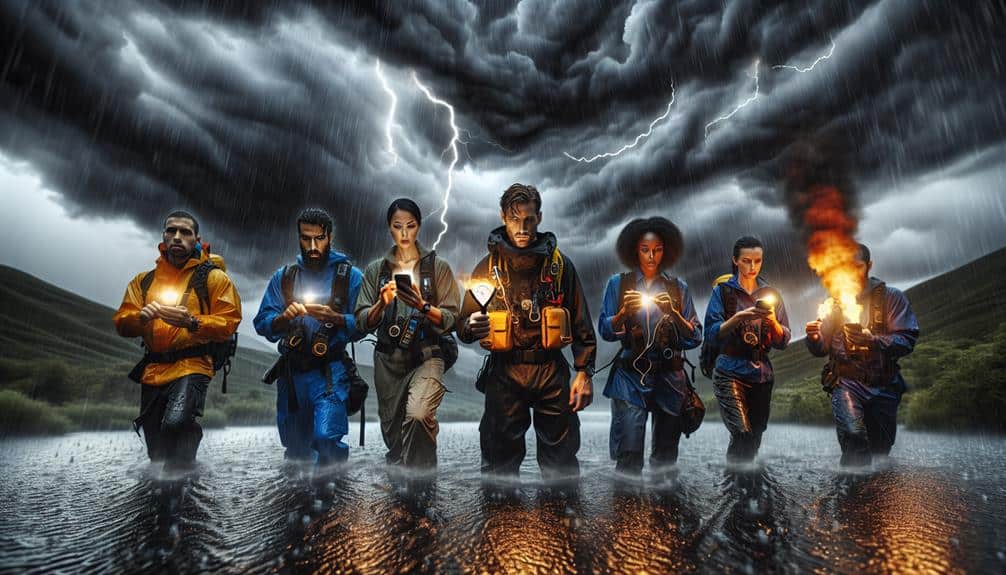We prioritize clear, efficient communication protocols with authorities to guarantee effective storm chasing operations and community safety. We maintain dedicated, encrypted communication lines and secure digital platforms for real-time data sharing with minimal latency. Regular training and periodic tests of communication channels guarantee accuracy and reliability. Emergency contact lists, updated monthly and stored on cloud-based platforms, streamline coordination. Real-time updates from advanced telemetry systems and GPS tools keep us connected with local agencies. Post-event, we review after-action reports to refine protocols further. By focusing on these best practices, you'll gain a thorough understanding of our structured approach.
Key Points
- Utilize Encrypted Radio Frequencies: Ensure secure communication with authorities via dedicated, encrypted radio frequencies for reliable and confidential data exchange during storm chasing.
- Real-Time Data Sharing: Employ advanced telemetry systems to provide authorities with real-time weather updates, ensuring rapid response and accurate situational awareness.
- Centralized Command Center: Establish a centralized command center to streamline communication and coordination with local agencies and authorities during severe weather events.
- Regular Drills and Training: Conduct regular training sessions and drills with local authorities to test and refine communication protocols, ensuring preparedness and effective response.
Establishing Clear Channels
To ensure effective communication, we must establish clear channels between storm chasers and local authorities from the outset. This foundational step enhances communication efficiency and guarantees effective coordination during storm events.
By setting up dedicated communication lines, we minimize confusion and maximize the rapid relay of critical information, which is essential for timely decision-making and public safety.
First, we need to define protocols for information exchange, including standardized reporting formats and designated communication methods. Utilizing encrypted radio frequencies and secure digital platforms can greatly enhance the reliability and confidentiality of transmitted data. Regular training sessions for both storm chasers and local authorities are essential to maintaining these standards.
Next, it's crucial to create a centralized command center that acts as the hub for all incoming and outgoing communications. This center will monitor storm chasers' locations and relay important updates to local authorities, ensuring that everyone remains on the same page. Data-driven strategies, such as GIS mapping and real-time tracking systems, can further strengthen our coordination efforts.
Real-Time Weather Updates
To guarantee timely decision-making, we rely on live data sharing with authorities, providing up-to-the-minute weather conditions.
Integrating our alert systems with local emergency services enhances coordination and responsiveness.
This synergy allows for proactive measures, reducing potential risks to both storm chasers and the public.
Live Data Sharing
We rely on advanced telemetry systems and mobile internet connections to share real-time weather updates with authorities. These systems enable us to transmit vital data like wind speed, humidity, and atmospheric pressure instantaneously.
Given the sensitive nature of weather data, we employ robust data encryption protocols to secure that our information remains safe. Privacy concerns are paramount; we guarantee that all transmitted data complies with strict privacy standards to protect both our team and the authorities we assist.
Our data sharing process is streamlined for efficiency. We use automated scripts and APIs to relay information directly from our sensors to centralized databases accessed by authorities. This seamless integration allows for real-time analysis and swift decision-making.
By continuously updating our telemetry systems, we secure minimal latency in data transmission, providing near-instant updates.
Our commitment to data integrity means we cross-verify all incoming data with multiple sources to ensure accuracy. This redundancy ensures that authorities receive the most reliable information possible.
We believe that real-time data sharing, when executed with technical precision and attention to privacy, empowers both storm chasers and authorities to act swiftly and effectively in mitigating the impacts of severe weather events.
Alert System Integration
By integrating our alert systems with real-time weather updates, we guarantee authorities receive immediate notifications of severe weather conditions. This integration is crucial for effective emergency response. When storm chasers collect data, our system processes it instantly, sending updates to local authorities through established communication protocols.
We use a combination of satellite feeds, radar data, and IoT devices to ensure extensive coverage. Our alert system prioritizes accuracy and speed, reducing the time it takes for information to reach first responders. This rapid dissemination allows for quicker evacuations, timely road closures, and targeted resource allocation, ultimately saving lives.
Through our streamlined communication protocols, we maintain a constant flow of real-time data. For instance, when a tornado is detected, our system sends automated alerts within seconds, providing precise coordinates and expected trajectories. Authorities can then act on this data without delay, implementing safety measures immediately.
Emergency Contact Lists

Let's discuss the importance of emergency contact lists in our storm chasing protocols.
We need to make sure we've key emergency contacts, rapid response numbers, and authority coordination channels readily accessible.
This enables us to respond swiftly and effectively during critical situations.
Key Emergency Contacts
Emergency contact lists are indispensable tools for storm chasers, guaranteeing prompt communication with local authorities, medical services, and weather monitoring agencies. These lists, forming the backbone of our safety procedures, are essential for emergency response and risk assessment.
Without accurate and updated contacts, our ability to enact rapid communication strategies is severely hindered. We must prioritize having the most current information to facilitate swift actions in critical moments.
Here are three critical types of contacts every storm chaser should include in their emergency list:
- Local Authorities: Police and fire departments can provide immediate assistance and important information during emergencies.
- Medical Services: Hospitals and emergency medical technicians (EMTs) should be on speed dial for any injuries or health crises.
Rapid Response Numbers
How do we ensure our emergency contact lists are always up-to-date and readily accessible for rapid response? We implement a systematic approach to guarantee that our emergency protocols are strong and efficient.
First, we audit our contact lists monthly, verifying numbers with local authorities and emergency services. This regular update cycle minimizes outdated information, enhancing our response time.
Next, we leverage cloud-based platforms to store these contact lists. Cloud storage provides real-time access, making sure that every team member can retrieve information swiftly, no matter their location. This method amplifies our communication efficiency, vital when seconds count during storm chasing.
We also integrate these contact lists into our mobile communication tools. By using apps that sync with our cloud storage, we can quickly dial emergency numbers without manual input, reducing potential for errors. This seamless integration supports our safety measures, allowing us to focus on the immediate task without compromising on emergency readiness.
Lastly, we conduct quarterly drills, simulating various scenarios to test our emergency protocols. These drills help us identify weaknesses and improve our procedures, guaranteeing we're always prepared.
In storm chasing, having up-to-date, accessible rapid response numbers isn't just smart—it's indispensable for our safety and operational success.
Authority Coordination Channels
Effective coordination with authorities depends on maintaining streamlined and accurate emergency contact lists. As storm chasers, we need to guarantee our emergency response is both prompt and efficient.
Detailed, up-to-date contact lists are essential for effective communication with local emergency management, law enforcement, and meteorological agencies.
To maintain high standards in our emergency response, we should:
- Regularly update contact information: Guarantee that our contact lists are reviewed and updated at least quarterly. This includes phone numbers, radio frequencies, and email addresses for key authorities.
- Categorize contacts by relevance: Organize contacts into categories such as local, state, and federal authorities. This helps in quickly identifying who to contact based on the situation's severity and location.
These practices not only streamline our communication but also enhance our credibility and reliability when coordinating with authorities.
Reporting Severe Weather
When reporting severe weather, we must promptly relay accurate data to authorities to guarantee timely public safety measures. Utilizing advanced weather monitoring tools, we track atmospheric changes and identify potential threats. Our precise data collection ensures that emergency response teams can implement effective safety measures. By providing real-time updates, we enhance community awareness and empower individuals to make informed decisions during weather emergencies.
Our process starts with continuous weather monitoring. We use radar, satellite imagery, and mobile weather stations to gather critical information. Once a severe weather event is detected, we immediately communicate with authorities through established channels. This rapid exchange of information is vital for activating emergency response protocols.
We emphasize data accuracy and clarity. Miscommunication can lead to delayed responses or ineffective safety measures. Hence, we verify our findings before reporting, ensuring that the data we share is both reliable and actionable. Authorities rely on our expertise to issue timely warnings, mobilize resources, and protect communities.
Coordination With Local Agencies
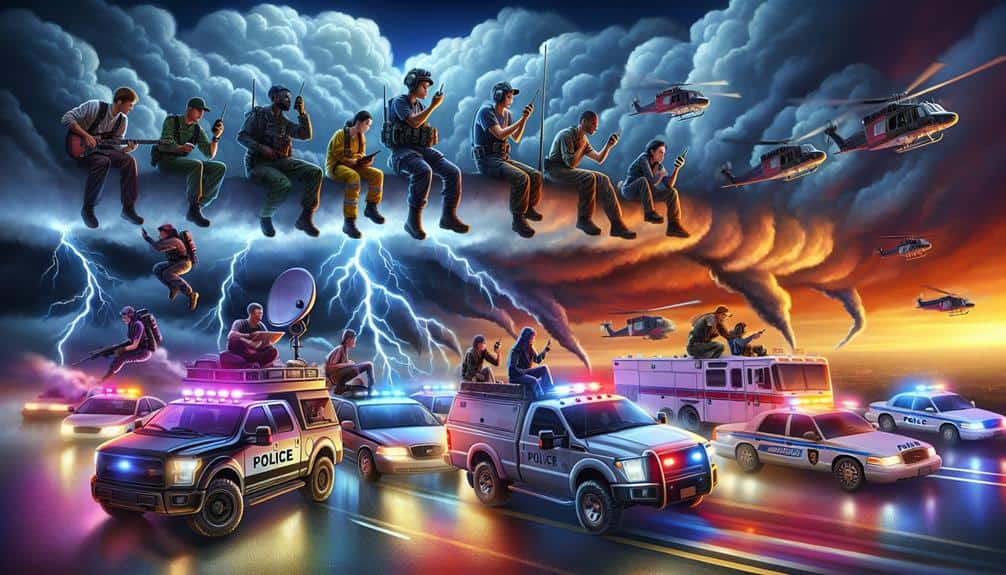
We coordinate closely with local agencies to streamline communication and guarantee swift, unified responses to severe weather events. This synergy is critical for effective emergency response. By working together, we minimize chaos and maximize efficiency, ensuring that resources reach affected areas promptly.
Community collaboration enhances our ability to gather real-time data and make informed decisions. Our joint efforts with local agencies involve:
- Shared real-time weather data: We provide authorities with up-to-the-minute storm information, helping them allocate resources efficiently.
- Predefined emergency protocols: We establish and follow standardized procedures to assure all parties are on the same page during a crisis.
These practices aren't just about data exchange but about building trust and familiarity with each other's operations. We focus on clear, concise communication to avoid misunderstandings and delays.
In emergency situations, rapid, coordinated action can save lives and property. By fostering strong community collaboration, we assure that our collective response is both agile and effective. Our streamlined protocols enable us to act swiftly and decisively, providing the support our communities need in times of severe weather.
Utilizing Radio Frequencies
Let's focus on how we utilize radio frequencies for effective communication during storm chasing.
We coordinate with emergency channels to guarantee our transmissions don't interfere with critical operations, adhering to strict signal clarity standards.
Emergency Channel Coordination
Coordinating emergency channels with authorities involves assigning specific radio frequencies to guarantee clear and reliable communication during severe weather events. By using dedicated frequencies, we make certain that our messages aren't only heard but acted upon swiftly, enhancing our emergency response capabilities.
To optimize our communication strategies, we implement the following techniques:
- Frequency Allocation: We assign specific radio frequencies for different teams and scenarios to prevent interference and maintain a clear line of communication.
- Regular Drills: We conduct periodic emergency response drills to make sure everyone knows their roles and can operate their equipment efficiently under pressure.
Our approach to emergency channel coordination is rooted in precision and adaptability. By maintaining a seamless connection with authorities, we can respond to emergencies more effectively and safeguard the safety of our team and the public. This method not only empowers us but also aligns with our commitment to freedom and responsibility.
In essence, clear and reliable communication during severe weather is paramount, and by following these coordination techniques, we strengthen our overall emergency response framework.
Signal Clarity Standards
To guarantee our emergency communications remain effective, maintaining signal clarity standards when utilizing radio frequencies is crucial. Clear communication guarantees the timely relay of critical weather updates and emergency response directives. To achieve this, we must monitor and enhance signal strength continually. Our communication protocols dictate regular checks of our radio equipment to prevent any degradation in signal quality.
Signal strength is paramount. We use high-gain antennas and appropriate power settings to optimize clarity and range. Additionally, we deploy band-pass filters to minimize interference from other frequencies, ensuring our messages are heard loud and clear. These measures are essential, especially during severe weather when other communication channels may fail.
Our protocols also include standardized language and codes to reduce misunderstandings. This standardization helps streamline emergency response, enabling us to act swiftly and efficiently. We conduct regular training to guarantee everyone on our team is proficient in these protocols.
Moreover, we utilize real-time weather updates to inform our positioning and communication strategies. By aligning our operations with the latest data, we maintain optimal signal clarity and guarantee our communications are both reliable and actionable. This rigorous approach empowers us to operate effectively in the field, safeguarding both our team and the communities we serve.
GPS Tracking Systems
In recent years, GPS tracking systems have become indispensable tools for storm chasers to relay live location data to authorities. These devices not only enhance our safety but also guarantee accurate and timely communication.
Maintaining our equipment is critical for reliability. Regular checks and updates prevent malfunctions during high-stakes situations. We need to make sure that our GPS units are fully operational, batteries are charged, and software is up-to-date. This vigilance minimizes the risk of equipment failure, which could jeopardize our safety and the efficacy of our operations.
Effective team communication is another cornerstone of our protocol. We rely on GPS tracking to maintain awareness of each other's positions, especially when storms reduce visibility. This situational awareness allows us to coordinate movements, avoid hazards, and provide mutual support.
- Live tracking: Immediate location updates help us and authorities make informed decisions.
- Route planning: GPS enables strategic navigation around severe weather.
Data Sharing Protocols
Sharing our GPS data with authorities in real-time synchronizes our movements and observations for maximum effectiveness. By leveraging data encryption, we guarantee that our shared information remains secure and accessible only to relevant parties. This encryption is critical, as it protects our sensitive data from unauthorized access, maintaining both our safety and the integrity of the information.
We also rely on robust communication backups to secure continuity. If our primary data-sharing channel encounters issues, these backups automatically kick in, guaranteeing that there's no interruption in the data flow. This redundancy is essential for maintaining real-time situational awareness and quick decision-making.
Our protocols include the use of secure cloud platforms that support encrypted data transfer and storage. We routinely test these systems to ensure their reliability under various conditions. Additionally, we employ dedicated software that allows seamless integration with emergency management systems used by authorities, securing that our data is instantly actionable.
Evacuation Procedures
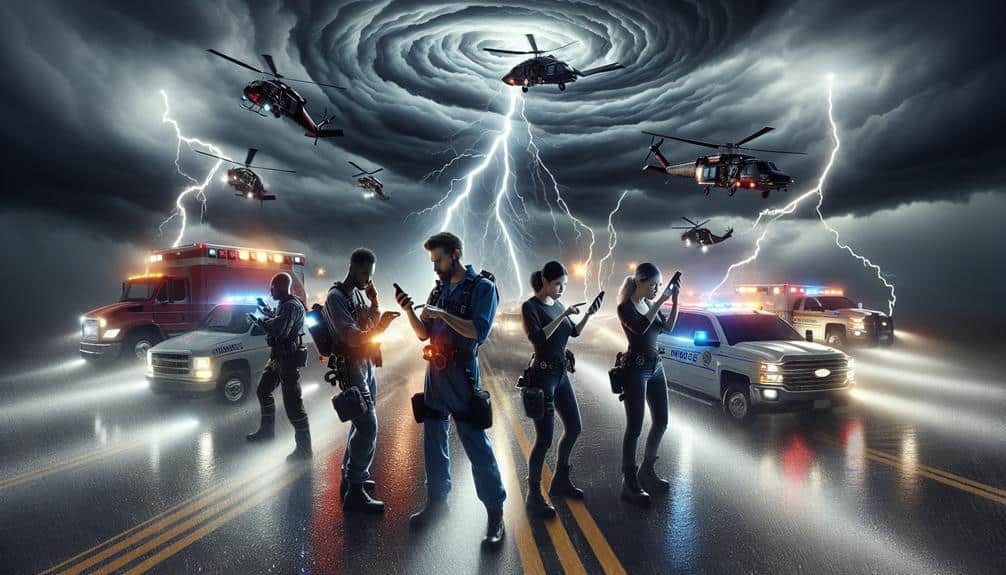
When severe weather conditions intensify, our evacuation protocols guarantee a prompt relocation to safety while maintaining communication with authorities. We prioritize clear evacuation pathways and have pre-identified emergency shelters to ensure smooth handovers. Our methods are grounded in disaster preparedness and strengthened by community outreach, guaranteeing everyone involved knows their role and responsibilities.
Our evacuation protocols consist of the following critical steps:
- Pre-planned Evacuation Routes: We map out multiple pathways in advance, allowing flexibility and quick adjustments based on real-time weather data.
- Coordination With Emergency Shelters: We establish connections with local shelters, ensuring they're prepared to accommodate us and any potential evacuees we might assist.
After-Action Reports
After-action reports provide us with essential insights by meticulously documenting our response and communication during severe weather events. By analyzing these reports, we can identify lessons learned and pinpoint improvements needed. This process is essential for enhancing our protocols and ensuring that we effectively communicate with authorities in future scenarios.
Our post-storm analysis focuses on areas where communication breakdowns occurred. We examine each instance of miscommunication or delay to understand its root causes. For example, we might find that specific radio frequencies were overcrowded or that our message relay system was inefficient. Addressing these issues allows us to develop more robust strategies and streamline our communication channels.
We also evaluate the timeliness and accuracy of the information we provided. Accurate, real-time data sharing is crucial for making informed decisions during a crisis. Hence, our after-action reports include a detailed review of data transmission methods and content accuracy.
Frequently Asked Questions
How Do Storm Chasers Handle Unexpected Road Closures During a Chase?
During a chase, hitting a roadblock feels like a storm itself. We use emergency plans and alternative routes, leveraging communication strategies and backup devices to guarantee we're not trapped, maintaining our freedom to pursue the storm.
What Qualifications Are Required to Become a Certified Storm Chaser?
To become certified storm chasers, we need weather expertise, emergency training, and navigation skills. We also must master communication protocols to guarantee safety and accuracy while tracking storms. These qualifications empower us to pursue our passion safely.
How Do Storm Chasers Ensure Their Safety While in Hazardous Conditions?
We secure our safety by following strict emergency protocols and constantly monitoring real-time weather updates. We use advanced tech and data analysis to anticipate changes, allowing us to make informed decisions and maintain our freedom while chasing.
What Type of Insurance Is Recommended for Storm Chasers?
Exploring insurance is like weathering a storm; we need extensive coverage options and strong liability protection. We suggest policies that include vehicle, equipment, and health insurance to guarantee we're protected against all potential risks in the field.
How Do Storm Chasers Maintain Their Vehicles for Extreme Weather Conditions?
We prioritize vehicle maintenance by regularly checking tires, brakes, and engine performance. For extreme weather preparation, we install reinforced windows, upgrade suspension systems, and confirm our vehicles have emergency kits, GPS, and communication tools.
